Every state on the East Coast is blessed with year-round fishing opportunities. And South Carolina is no exception. With two dozen lakes, numerous rivers, a myriad of creeks, more than 300,000 acres of salt marshes, and the Atlantic Ocean under its belt, the fishing season in South Carolina never ends. But does this mean you can wet your line in the “Palmetto State” at any time and get hold of a trophy fish? Is it really that simple?

Well, not really. While a fish may grace the end of your line at any time of the year, it might not be the fish you had in mind. Rest assured, you won’t return home empty-handed after fishing in South Carolina, but you’ll amp up your chances of landing the prize catch if you learn what’s biting and when exactly.
We’ll walk you through South Carolina’s fishing seasons to help you prepare for your Palmetto State fishing frenzy. You’ll find a month-by-month breakdown of angling conditions and fish species further down. There’s a lot to unearth, so let’s get started!
What can I expect from South Carolina’s fishing seasons?
South Carolina is a year-round angling playground. Be it river, lake, marsh, or ocean fishing, you’ll always have a hotspot to explore. What varies throughout the year, however, are the fish species and their brag-worthy qualities. Saltwater and freshwater fishing seasons in South Carolina slightly differ, too. So, the ideal time to go fishing depends on the type of fish you want to catch and the fishery you want to conquer.
Saltwater Fishing

South Carolina’s altwater fisheries are teeming with life. You can reel in anything from Redfish, Flounder, and Tarpon, to Mahi Mahi, Tuna, and Billfish. But not all areas give outstanding results all the time. The majority of year-round residents patrol regions closer to the shore. Meanwhile, the deep blue features primarily seasonal monsters. That being said, take a look at the most commonly caught saltwater species in South Carolina and their abundance during each month of the year.
| Species | Jan | Feb | Mar | Apr | May | Jun | Jul | Aug | Sep | Oct | Nov | Dec |
|---|---|---|---|---|---|---|---|---|---|---|---|---|
| Amberjack | Good | Good | Good | Good | Good | Good | Good | Good | Good | Good | Good | Good |
| Black Drum | Great | Great | Great | Great | Great | Great | Great | Great | Great | Great | Great | Great |
| Bluefish | Great | Great | Great | Great | Great | Great | Great | Great | Great | Great | Great | Great |
| Cobia | Weak | Weak | Weak | Good | Good | Great | Great | Great | Good | Fair | Weak | Weak |
| Flounder | Weak | Weak | Weak | Fair | Good | Good | Good | Great | Great | Great | Good | Weak |
| Kingfish | Fair | Fair | Fair | Good | Good | Great | Great | Great | Good | Fair | Fair | Fair |
| Mahi Mahi | Fair | Fair | Fair | Good | Great | Great | Great | Great | Good | Good | Fair | Fair |
| Marlin | Weak | Weak | Weak | Fair | Good | Great | Great | Great | Great | Good | Fair | Weak |
| Redfish | Great | Great | Great | Great | Great | Great | Great | Great | Great | Great | Great | Great |
| Sailfish | Weak | Weak | Weak | Weak | Fair | Fair | Great | Great | Great | Good | Fair | Weak |
| Speckled Trout | Great | Great | Great | Great | Great | Great | Great | Great | Great | Great | Great | Great |
| Tarpon | Weak | Weak | Weak | Fair | Fair | Good | Great | Great | Good | Fair | Fair | Weak |
| Tuna | Good | Good | Good | Good | Great | Great | Great | Great | Good | Good | Good | Good |
| Wahoo | Weak | Weak | Weak | Fair | Good | Great | Great | Great | Great | Great | Good | Fair |
Freshwater Fishing
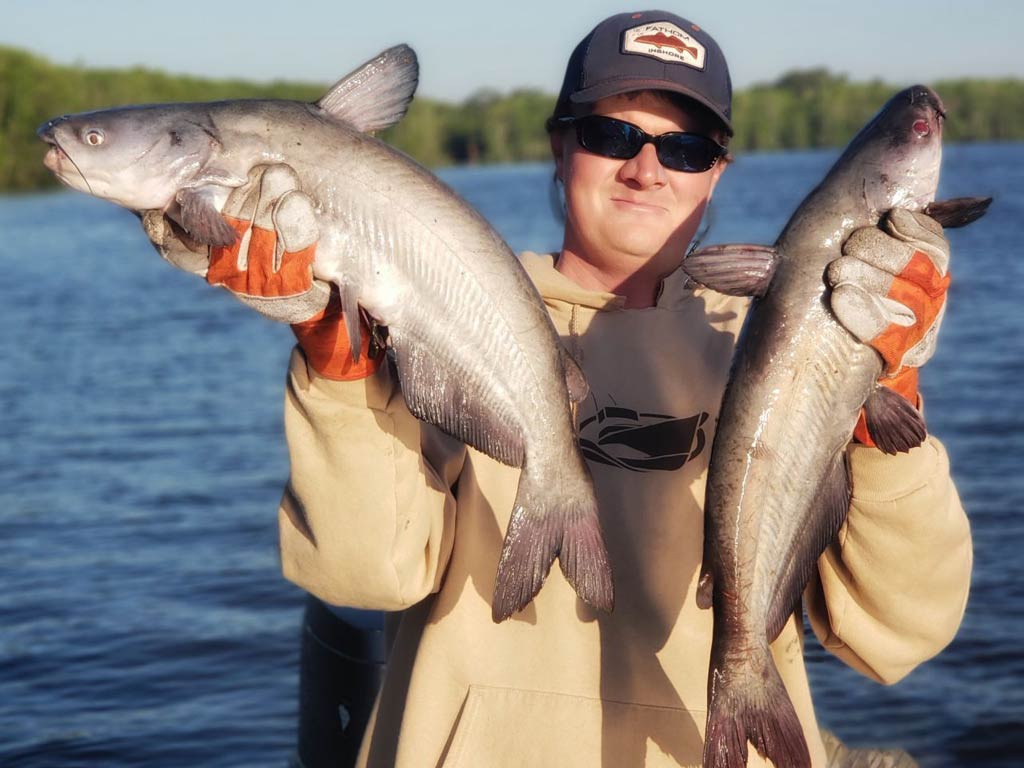
Similar to saltwater fishing, freshwater adventures provide non-stop entertainment. But the fish offer varies a lot depending on the season. Bass, for example, dominate the underwater world in spring and fall, whereas Catfish steal the spotlight in summer. So, if you want a memorable catch, you have to be on the lookout for the best conditions. But let’s see how that translates into the grid view below.
| Species | Jan | Feb | Mar | Apr | May | Jun | Jul | Aug | Sep | Oct | Nov | Dec |
|---|---|---|---|---|---|---|---|---|---|---|---|---|
| Catfish | Weak | Weak | Weak | Fair | Good | Good | Good | Great | Great | Great | Good | Good |
| Crappie | Good | Good | Good | Good | Good | Great | Great | Good | Great | Great | Good | Fair |
| Striped Bass | Good | Good | Good | Great | Great | Good | Good | Good | Great | Great | Great | Good |
| Largemouth Bass | Good | Good | Good | Great | Great | Great | Good | Good | Great | Great | Great | Good |
| Perch | Fair | Fair | Good | Good | Great | Great | Great | Good | Good | Good | Good | Fair |
| Trout | Weak | Weak | Good | Great | Great | Good | Fair | Fair | Good | Great | Great | Fair |
When is South Carolina’s best fishing season?
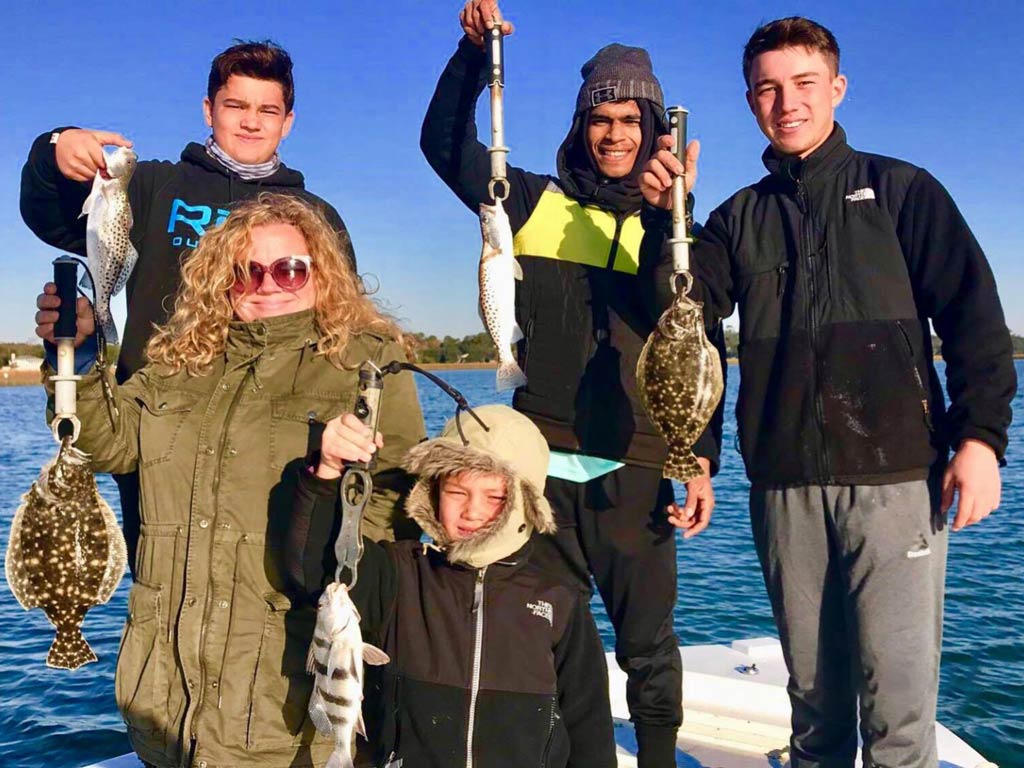
South Carolina’s best fishing season is when your fish is biting. Since the availability of the fish may vary, the most reliable way to know what’s currently biting is by checking out what South Carolina’s guides are reporting at the moment. Other than that, you can always use this blog as a reference. Let’s see what month of the year suits you best for going on a South Carolina angling quest.
January
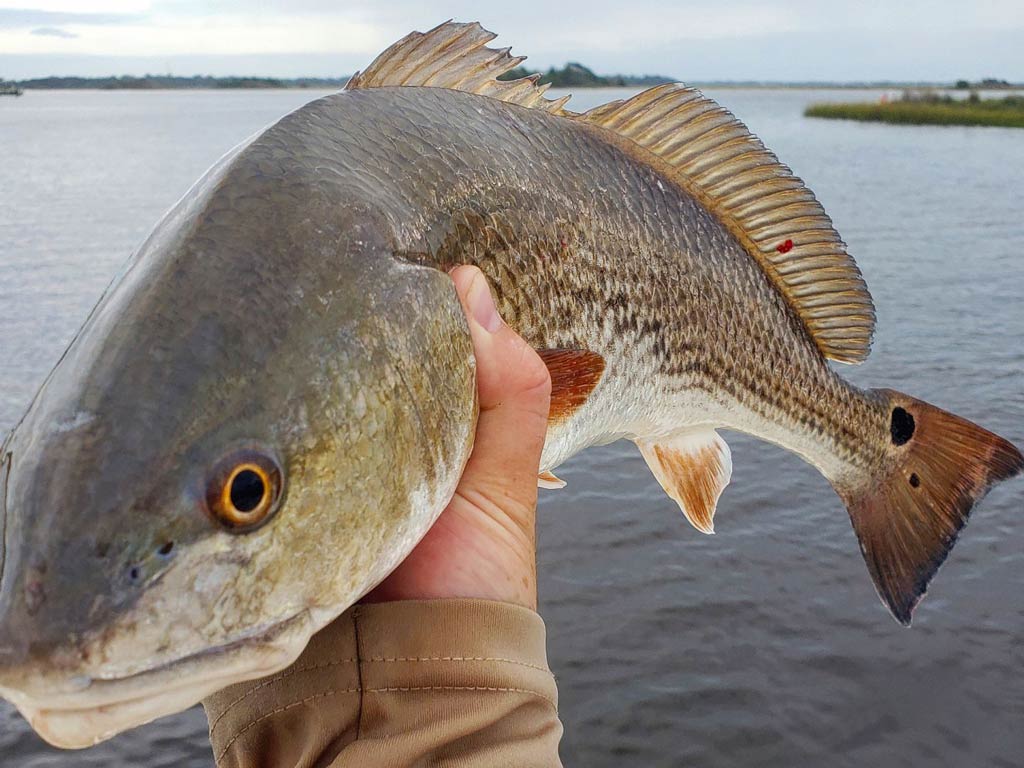
Summer is synonymous with spectacular fishing, but winter isn’t lagging far behind either. Despite being the coldest month of the year, January brings fiery inshore action. This is especially true for Speckled Trout. Some of the biggest specimens could be found around January’s full moon. Besides Gator Trout (impressively large fish), expect equally satisfying Redfish and Black Drum in the estuaries.
Unlike saltwater fishing, freshwater angling slows down when the temperature drops. While January isn’t the most prolific month for exploring the rivers and lakes in South Carolina, you can always count on Bass. As the winter progresses, they’re harder to locate but you can still lure them your way by jigging spoons in deeper lakes or mountain creeks.
February
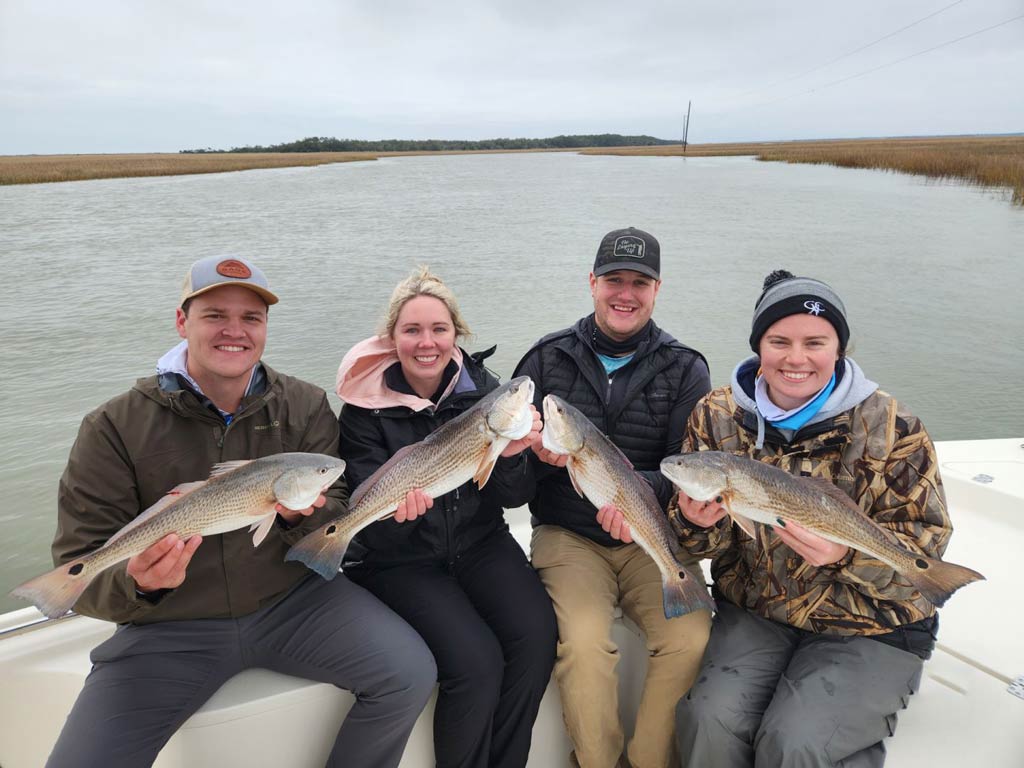
If you succumbed to a winter slumber in January, this is your last chance to see what South Carolina’s angling can be like during the cold months. So, before spring takes over, prepare enough shrimps and go after stubborn fellas such as Redfish, Black Drum, and Speckled Trout. Besides coastal fisheries, February will treat you with a serious bluewater match, too. Move further offshore and, if you’re lucky, you may test your skills against Tuna.
Freshwater fishing in February is a kind of make-it-or-break-it situation. While you can’t rely on quantity and consistency, the second month of the year can certainly surprise you with trophy catches. Huge female Bass are preparing to migrate upstream to spawn and they’ll start noticing your crankbaits and mop jigs. Apart from Largemouth Bass, Lake Moultrie and Lake Marion offer decent Catfish, too.
March
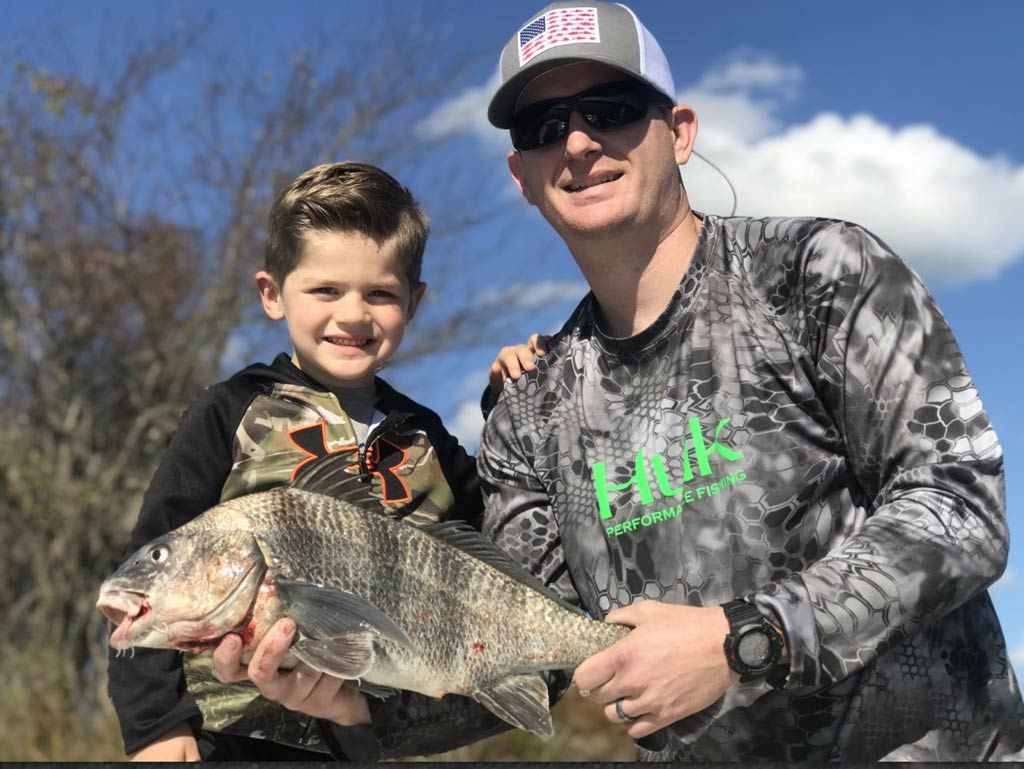
Speckled Trout, Black Drum, and Redfish are still going strong in March. Black Drum fishing in Murrells Inlet in particular can be quite thrilling. Now that the water temperatures are slowly rising, Flounder are returning to their inshore habitat. Further from the shore, you can spice up your saltwater experience with Sheepshead, Bluefish, and Tuna.
In terms of freshwater species, expect the same offer as in February. Again, March is reserved for lunkers. With the spawning season around the corner, these chunky specimens will only think about moving upstream and grabbing something to eat on the way. This means you’ll easily find them and you won’t have a problem with your bait presentation. Bear in mind, however, that the waters aren’t that warm yet. Instead of a sunrise trip, get out on the water later during the day.
April
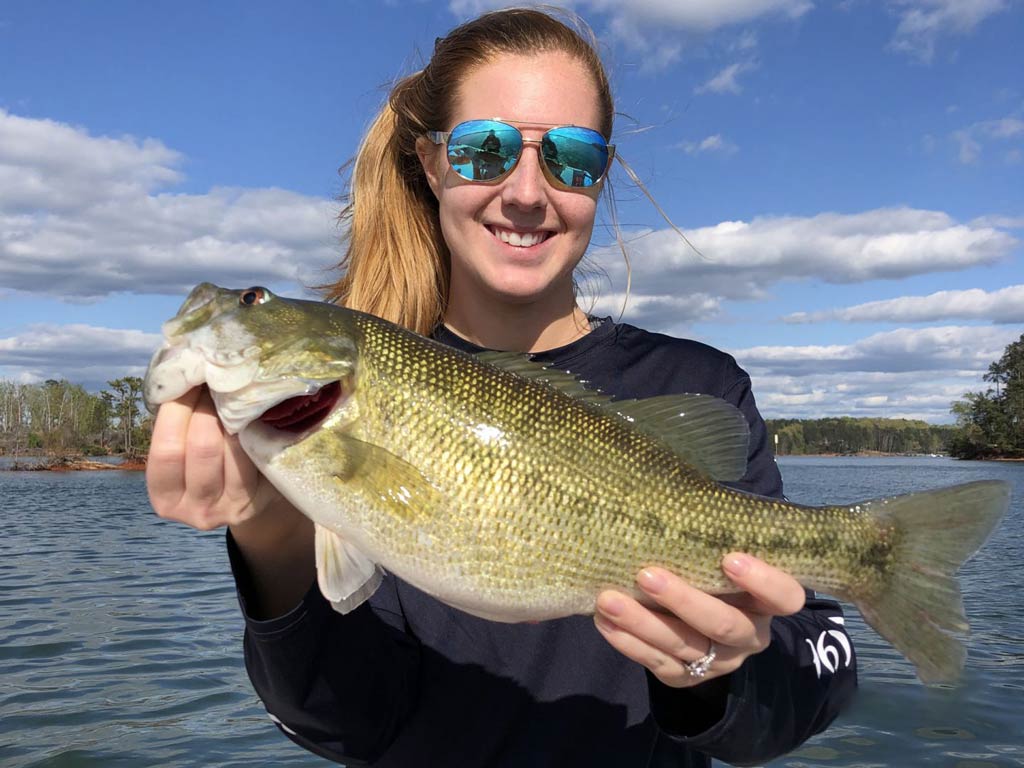
With winter in the rearview mirror, fishing in South Carolina is heating up. Mid-April is the unofficial beginning of the big game angling season. Deep blue debutantes, Mahi Mahi, join the saltwater party in style. Mahi Mahi concentrations in April vary. You can find them anywhere in depths between 180 and 600 fee, but rigged ballyhoo should do the trick of attracting them. Along with Mahi Mahi, the end of the month brings Kingfish and Cobia, too.
Freshwater angling is dominated by Bass come April. With Bass patrolling the shallows, it’s time for you to dust off your fly fishing equipment and hit one of many high-ranked spring reservoirs like Lake Wateree. You can start intriguing your target with floating worms and then try introducing more magnetic topwater baits. If you’re into other species, don’t worry, April promises decent Catfish, Perch, and Crappie as well.
May
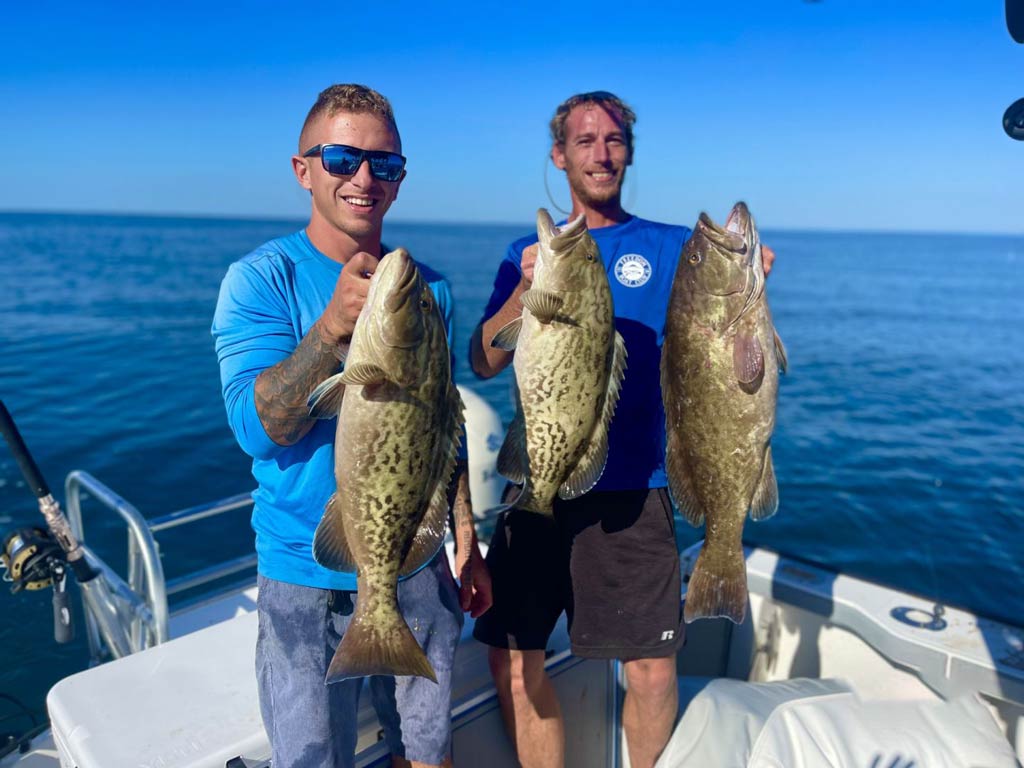
We can say with certainty that the fishing season in South Carolina finally reaches its peak in May. Bull Reds rule the area around jetties, Mahi Mahi and Cobia meander the deep blue, reefs and wrecks become all the rage thanks to the Snapper and Grouper seasons being opened, and Amberjack enters the saltwater scene. May offers great pier fishing opportunities, too. Just ask anyone who fished from Apache Pier in Myrtle Beach.
Meanwhile, freshwater fisheries are an ongoing playground for Bass. Lake Russell and Lake Wylie are brimming with Black Bass, out of which Largemouth varieties are the most prominent species. The post-spawn Bass will inhabit the shallow and vegetation-rich waters closer to the shore. May is a period of transition for Perch and they’ll find weedy and grassy areas attractive, too.
June

June opens the door to even more possibilities. Sharks, for example, start frequenting flats and estuaries so much that you’ll be able to sight fish for them. Spinner, Lemon, Bonnethead, Bull, Blacktip, Tiger, or Blacknose Sharks – South Carolina and early summer have them all! If you’re more into Cobia, check out Port Royal Sound. But if speedsters such as Wahoo and Marlin are on your radar, then venture far offshore and start conquering the deep blue.
June is a good time for moving away from the bank and exploring the deeper lake waters. Don’t confuse this with prolific angling, though. Most species are well-hidden and you’ll have to roll up your sleeves to find them. For Striped, Hybrid, and Largemouth Bass, hit Lake Hartwell. Lake Jocassee, on the other hand, promises Rainbow and Brown Trout challenges.
July
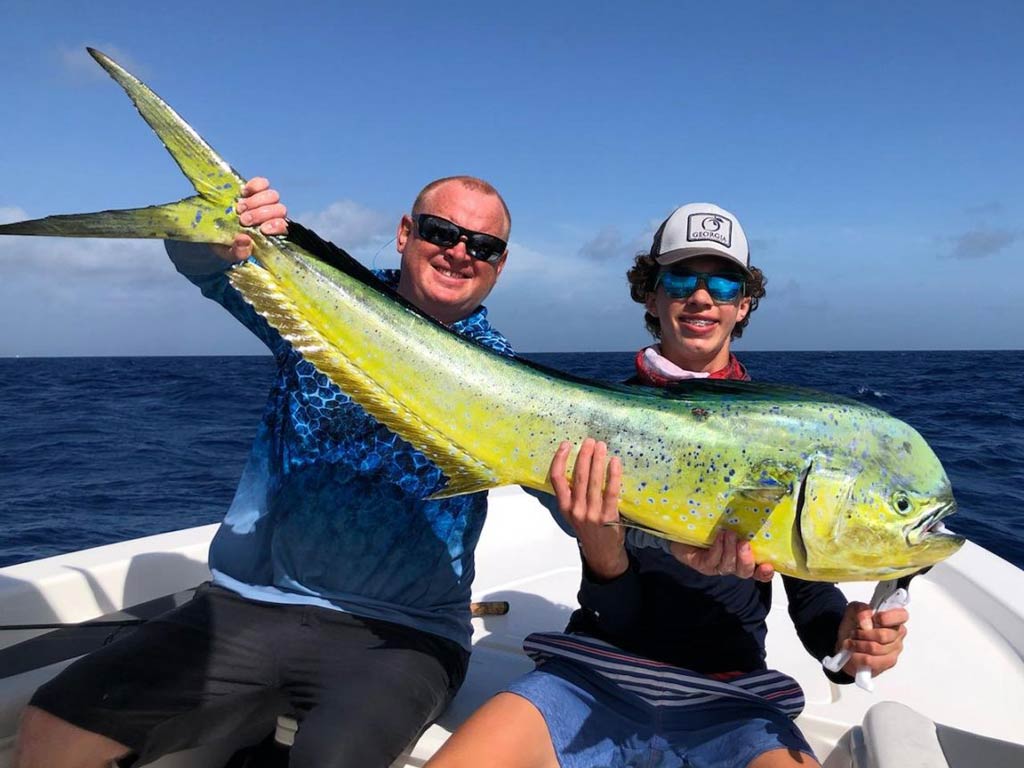
Once the hottest month of the year ascends the throne, angling in South Carolina transforms from great to superb. July brings excellent weather conditions and calm seas. Pair those up with the big bluewater names that emerge in July and it becomes clear that this is one of the best seasons in South Carolina for deep sea fishing. Sailfish, Blue Marlin, White Marlin, Mahi Mahi, Wahoo, and Yellowfin Tuna are all waiting for you offshore!
While July obviously has its perks, summer temperatures aren’t always beneficial. Many fish species move to the deeper waters and some will even scatter, making it more difficult for you to locate them. Also, instead of midday hunts, you should gear your angling efforts toward early mornings and late evenings. All this applies to both freshwater and saltwater fishing in South Carolina in July.
August

Much like its predecessor July, August continues the trend of tight lines. The Sailfish offer is excellent. You can hook smaller specimens as close as 10 miles offshore! For more impressive opponents, you’ll need to hit the Gulf Stream around the 50-mile mark. If you want to stay closer to shore, estuaries are abundant in Flounder, the jetties are teeming with Sheepshead, and the surf yields decent Whiting. Oh, and there’s plenty of Tarpon. Not bad, eh?
While a bluewater pursuit is as intense as ever in summer, the freshwater hunt subsides. This doesn’t mean that you’ll end up empty-handed and that you should give up on fishing in August altogether. It just means that Bass seek better hideouts and fishing for them isn’t as easy as it has been before. Luckily, you can always count on Catfish! They aren’t afraid of the scorch and you’ll find plenty of Blue, Channel, and Flathead Catfish in Lake Wylie.
September
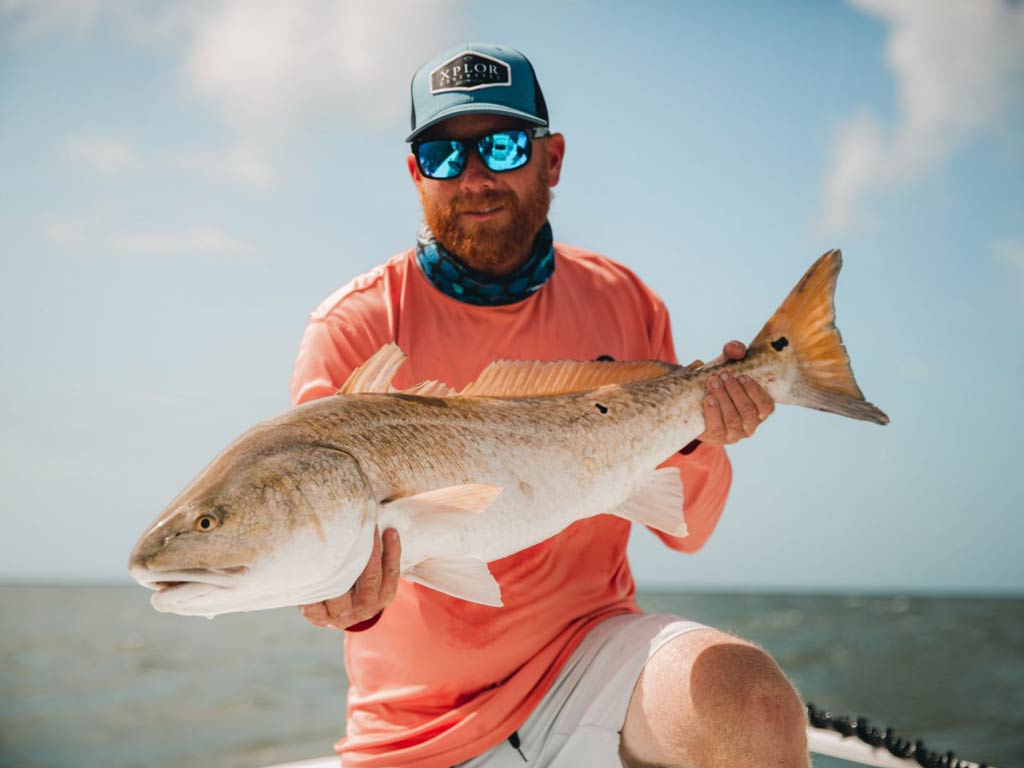
If you haven’t had the chance to test your skills against Sailfish, September is high time you changed this. For another couple of weeks, Sailfish will rule South Carolina’s saltwater realm and there’s no excuse for you not to go after them. Summer is still in full swing, so the inshore and offshore waters are overflowing with fish species. From Drums to Billfish, September won’t disappoint you.
While angling patterns in September resemble those present in August, this is a transition period for freshwater fish. Late summer and early fall is the time of the year when Largemouth Bass migrate from the deep waters to tributary creeks on Lake Jocassee. It’s also the beginning of the great Crappie season on Santee.
October
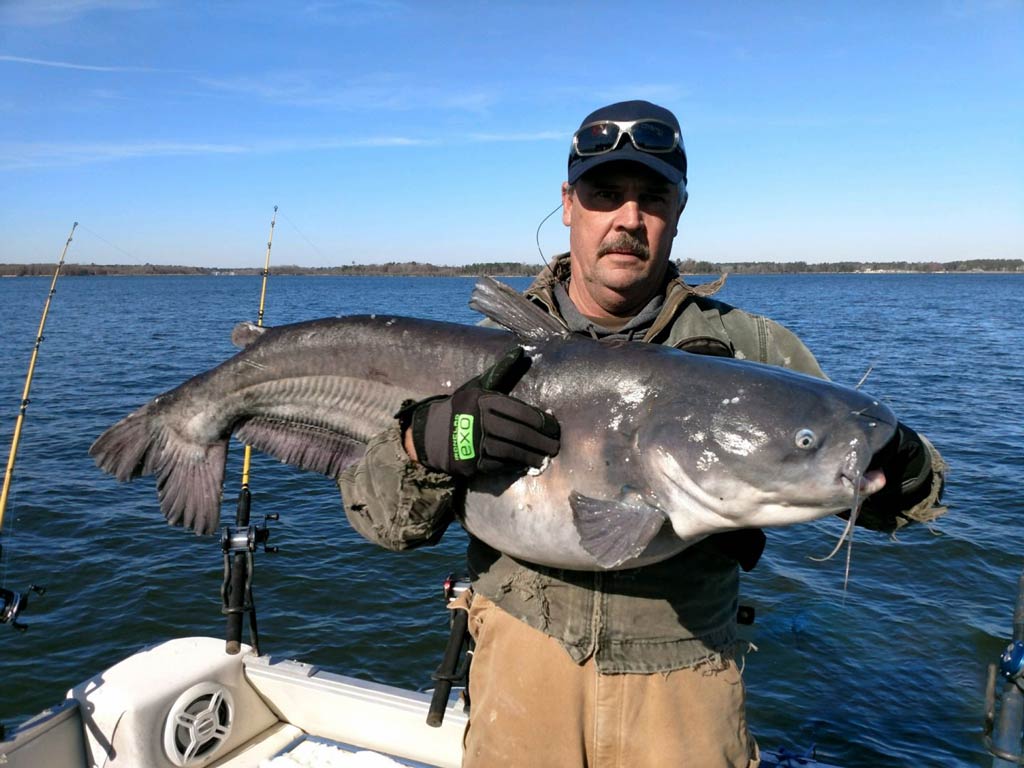
The weather is fantastic, the waters are calm, and the fish are omnipresent. Angling in October is simply spot-on! The inshore waters are loaded with bait fish and Reds can’t resist them. Bull Reds will be schooling in the shallows for another couple of weeks, so October is the perfect time for reintroducing fly casting. Also, Tarpon fishing is as good as it gets. And bottom fishing is equally productive with Snappers and Groupers.
Fall is a magic word in the freshwater fishing world. This is the season when Largemouth Bass, Striped Bass, Crappie, Catfish, and Trout thrive. Striped Bass also start frequenting Santee Cooper‘s surface after hiding in the deeper waters the whole summer. They also tend to congregate in schools, so make sure you don’t approach them aggressively, or else you’ll spook them out.
November
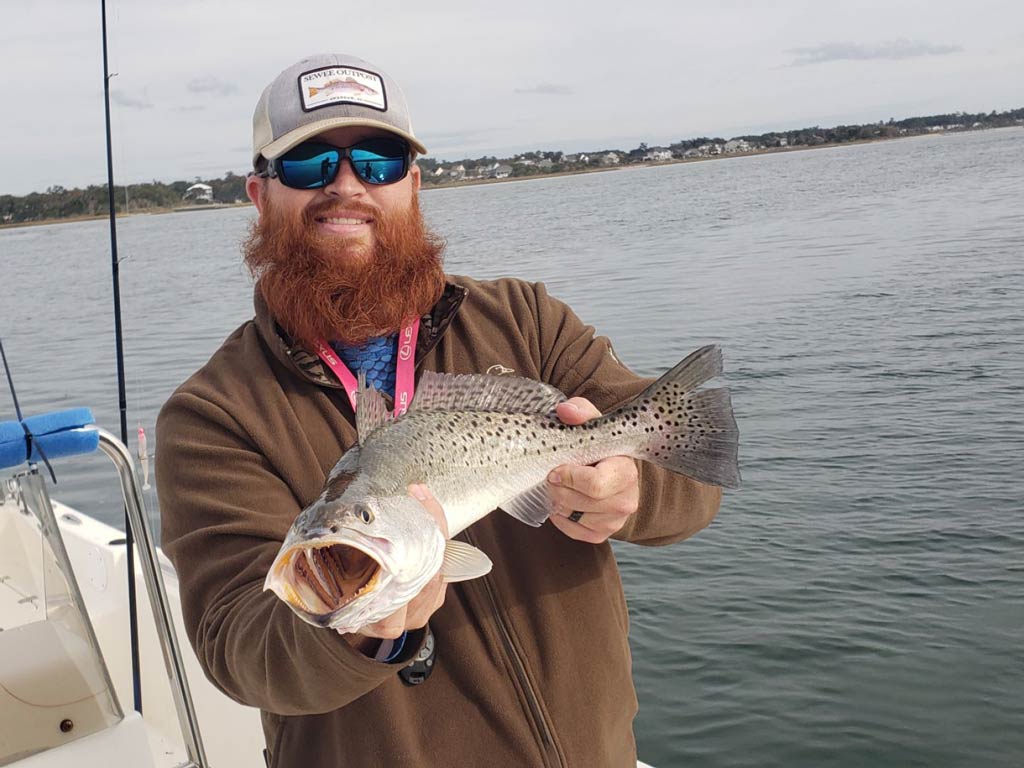
The inshore fisheries don’t cease to amaze in late fall. What’s more, November might be the prime time for going after Reds and Specks. Falling tides and shrimps seem to be a winning combo for reeling them in. You can also find a lot of Flounder, but they might not be of legal size for keeping. November is your last call for top-tier offshore hunting before the temperature drops too much. Gear up for a last dance with Mahi Mahi, Mackerel, Tuna, and Billfish.
It’s high time Striped Bass dominated the fishing season in South California. There’s plenty of shad, so luring Stripers your way won’t be difficult. November is ideal for targeting big Bream and tons of Crappie, too. And, while Catfish angling isn’t exploding, you can still catch decent specimens at night. Use shad to attract them as well, and focus on waters anywhere between 2–10 feet deep.
December
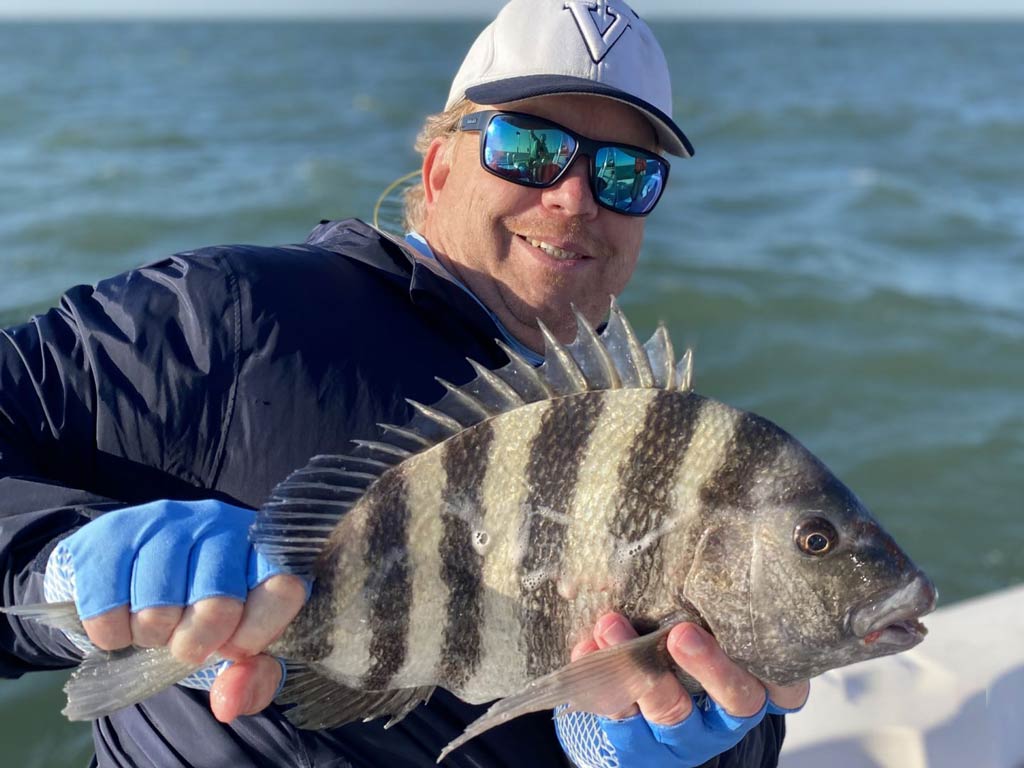
The end of the year doesn’t mean the end of fishing. Yes, the offshore pursuits become more challenging as winter approaches. An yes, the fog can get pretty thick and temperatures really low. But you can still go out if the weather conditions are right and the seas are calm. You can stumble on daring Sheepshead, and if you’re lucky, on an occasional Tuna, too. Pretty good for the “off-season”.
Freshwater fishing isn’t as intense as it used to be, either, but there’s still good action to be had. Lake Russell, for example, boasts great Stripers. Lake Wylie, on the other hand, can brag about the biggest Catfish. Meanwhile, the top of Lake Wateree holds a bunch of Crappie. If you’re after Bass, note that the winter in South Carolina sees Bass move into the deeper waters.
South Carolina Fishing Seasons: A Neverending Story
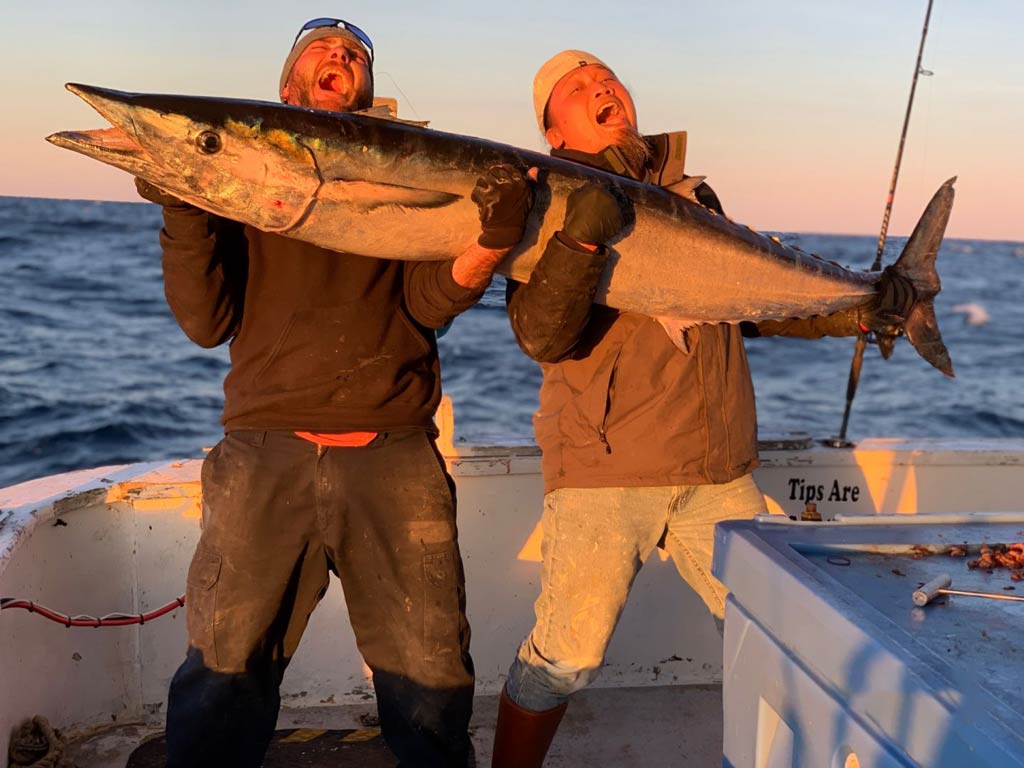
As you can see, the best season to fish in South Carolina is whenever you set your mind to do it. Angling in South Carolina is a non-stop fishing frenzy. You can wet your line in the Lowcountry’s waters any time of the year and end up with a Panfish or two. The only difference between a decent dinner catch and a memorable bragging story is timing. So, if you know what fish you want to target, align your hunt with their peak season. It’s as simple as that. Tight lines!
What are your favorite months to fish in South Carolina? Do you prefer one season over the other? Hit the comment button below and share your thoughts about South Carolina’s fishing seasons with us!
The post South Carolina Fishing Seasons: The Complete Guide appeared first on FishingBooker Blog.
https://ift.tt/NZ9GlBh
0 Comments
Enregistrer un commentaire